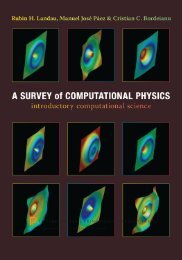- Page 8:
Preface“More is different” is a
- Page 12:
ContentsPart I General Principles1
- Page 16:
ContentsIX7 Magnetic Materials ....
- Page 24:
Part IGeneral Principles
- Page 28:
4 1 Thermal Equilibrium and the Pri
- Page 34:
1.2 Thermal Equilibrium 7environmen
- Page 38:
1.3 Kinetic Theory of Gas Molecules
- Page 42:
1.3 Kinetic Theory of Gas Molecules
- Page 46:
1.3 Kinetic Theory of Gas Molecules
- Page 50:
1.3.2 Velocity Distribution of an I
- Page 56:
18 1 Thermal Equilibrium and the Pr
- Page 60:
20 1 Thermal Equilibrium and the Pr
- Page 64:
2EntropyIn the previous chapter, we
- Page 68:
2.1 The Microcanonical Distribution
- Page 72:
2.2 Number of States and Density of
- Page 76:
2.3 Conditions for Thermal Equilibr
- Page 80:
2.3 Conditions for Thermal Equilibr
- Page 84:
2.4 Thermal Nonequilibrium and Irre
- Page 88:
36 3 The Partition Function and the
- Page 92:
38 3 The Partition Function and the
- Page 96:
40 3 The Partition Function and the
- Page 100:
42 3 The Partition Function and the
- Page 104:
44 3 The Partition Function and the
- Page 108:
4Ideal GasesHere, we shall apply st
- Page 112:
4.2 Phase Space and the Number of M
- Page 116:
4.3 Entropy of an Ideal Gas 51Fig.
- Page 120:
4.3 Entropy of an Ideal Gas 53Final
- Page 124:
4.5 Statistical-Mechanical Temperat
- Page 128:
4.6 Partition Function of an Ideal
- Page 132:
4.7 Diatomic Molecules 59Fig. 4.7.
- Page 136:
4.7 Diatomic Molecules 614.7.3 Vibr
- Page 140:
4.7 Diatomic Molecules 63Fig. 4.9.
- Page 144:
4.7 Diatomic Molecules 65Thendε=(2
- Page 148:
5The Heat Capacity of a Solid,and B
- Page 152:
5.1 Heat Capacity of a Solid I - Ei
- Page 156:
5.2 Heat Capacity of a Solid II - D
- Page 160:
5.2 Heat Capacity of a Solid II - D
- Page 164:
5.2 Heat Capacity of a Solid II - D
- Page 168:
5.3 Black-Body Radiation 77Fig. 5.7
- Page 172:
5.3 Black-Body Radiation 79Fig. 5.8
- Page 176:
5.3 Black-Body Radiation 81antenna
- Page 180:
84 6 The Elasticity of Rubberlength
- Page 184:
86 6 The Elasticity of Rubber6.4 Ho
- Page 188:
7Magnetic MaterialsWe have applied
- Page 192:
7.2 Statistical Mechanics of a Free
- Page 196:
7.2 Statistical Mechanics of a Free
- Page 200:
7.2 Statistical Mechanics of a Free
- Page 204:
7.3 Ising Model - Mean-Field Approx
- Page 208:
7.3.2 Mean-Field Approximation7.3 I
- Page 212:
7.3 Ising Model - Mean-Field Approx
- Page 216:
7.3 Ising Model - Mean-Field Approx
- Page 220:
7.3 Ising Model - Mean-Field Approx
- Page 224:
7.4 The One-Dimensional Ising Model
- Page 228: 7.4 The One-Dimensional Ising Model
- Page 232: 7.4 The One-Dimensional Ising Model
- Page 236: 8First-Order Phase TransitionsIn th
- Page 240: 8.1 The Various Phases of Matter 11
- Page 244: 8.2 System in a Heat Bath at Fixed
- Page 248: 8.3 Coexistence of Phases 1218.3 Co
- Page 252: 8.4 The Clausius-Clapeyron Law 123s
- Page 256: 8.4 The Clausius-Clapeyron Law 125F
- Page 260: 8.5 The Critical Point 127The reaso
- Page 264: 8.6 The van der Waals Gas 129Fig. 8
- Page 268: 8.6 The van der Waals Gas 131Here t
- Page 272: 134 9 Second-Order Phase Transition
- Page 276: 136 9 Second-Order Phase Transition
- Page 282: 9.2 Landau Theory 139andU(T,V,N)=F
- Page 286: whereand9.3 The Two-Dimensional Isi
- Page 290: 9.3 The Two-Dimensional Ising Model
- Page 294: 9.3 The Two-Dimensional Ising Model
- Page 298: 148 10 Dense Gases - Ideal Gases at
- Page 302: 150 10 Dense Gases - Ideal Gases at
- Page 306: 152 10 Dense Gases - Ideal Gases at
- Page 310: 154 10 Dense Gases - Ideal Gases at
- Page 314: 156 10 Dense Gases - Ideal Gases at
- Page 318: 158 10 Dense Gases - Ideal Gases at
- Page 322: 160 10 Dense Gases - Ideal Gases at
- Page 326: 162 10 Dense Gases - Ideal Gases at
- Page 330:
164 10 Dense Gases - Ideal Gases at
- Page 334:
166 10 Dense Gases - Ideal Gases at
- Page 338:
168 10 Dense Gases - Ideal Gases at
- Page 342:
170 10 Dense Gases - Ideal Gases at
- Page 346:
172 10 Dense Gases - Ideal Gases at
- Page 350:
174 10 Dense Gases - Ideal Gases at
- Page 354:
176 10 Dense Gases - Ideal Gases at
- Page 358:
178 10 Dense Gases - Ideal Gases at
- Page 362:
180 10 Dense Gases - Ideal Gases at
- Page 366:
Part IVAppendices
- Page 370:
186 Formulas Related to the Factori
- Page 374:
188 The Gaussian Distribution Funct
- Page 378:
190 The Gaussian Distribution Funct
- Page 382:
192 Lagrange’s Method of Undeterm
- Page 386:
194 Volume of a HypersphereNow let
- Page 390:
196 Hyperbolic FunctionsTheir deriv
- Page 394:
198 Boundary ConditionsHere n must
- Page 398:
GThe Riemann Zeta FunctionThe Riema
- Page 402:
References1. C. Seife: Science 302,
- Page 406:
206 Indexdensity of states 26diamon
- Page 410:
208 Indexsymmetry 134temperature 7,











![Práctica [PDF] - Universidad de Carabobo, FACYT - computacion](https://img.yumpu.com/48491415/1/190x245/practica-pdf-universidad-de-carabobo-facyt-computacion.jpg?quality=85)




